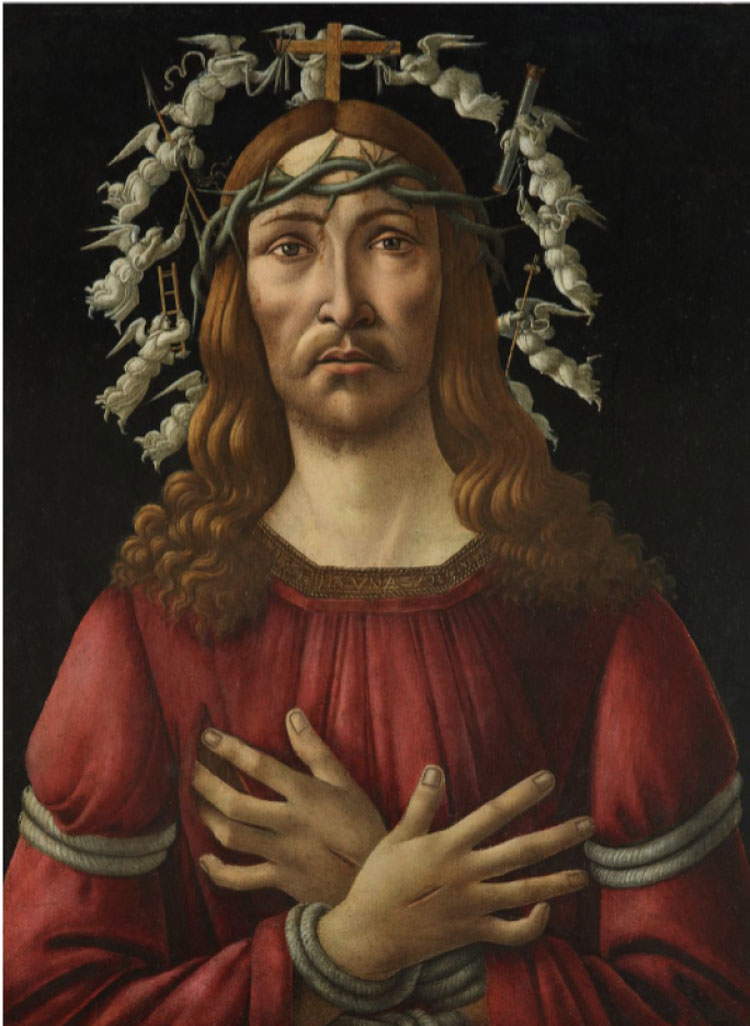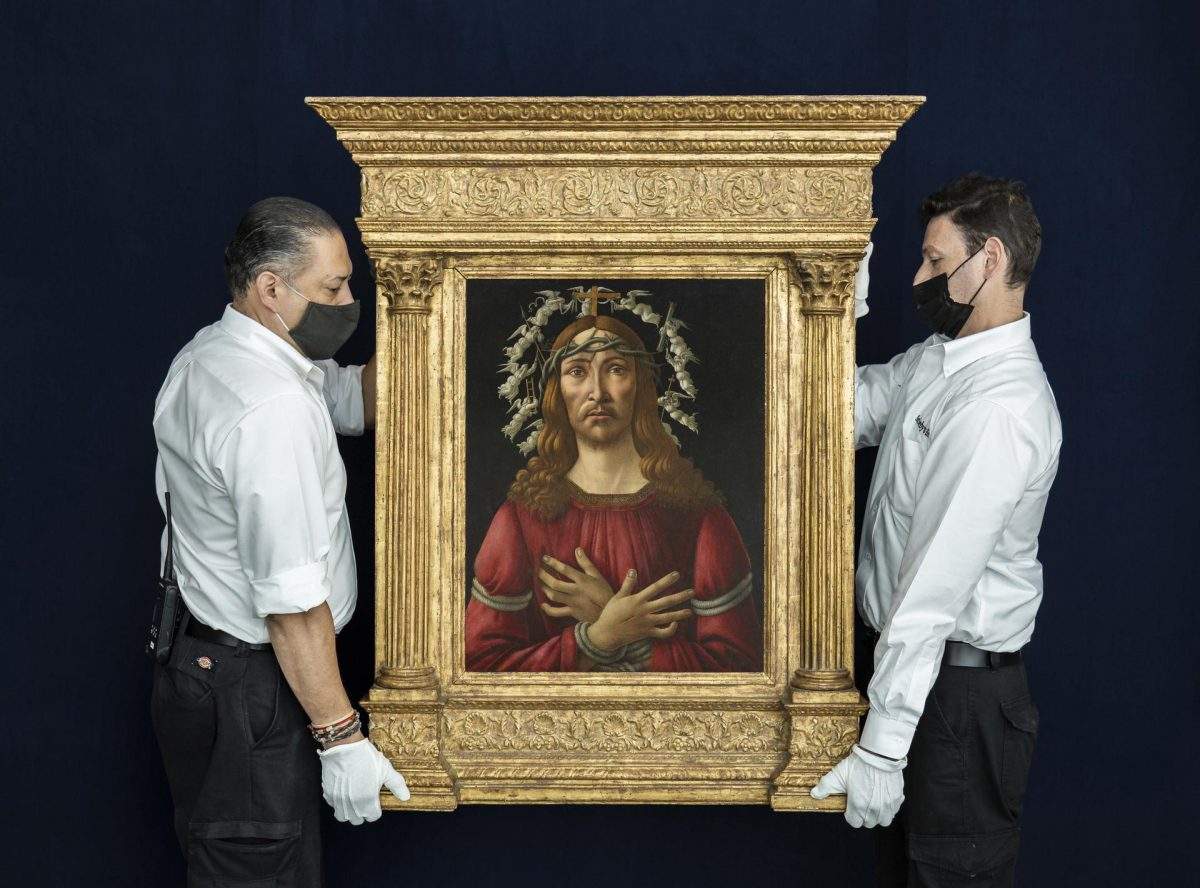Going up for auction at Sotheby ’s is Sandro Botticelli ’s (Florence, 1445 - 1510) Vir dolorum, one of the artist’s most important works remaining in private hands.The painting will be featured at Sotheby’s Masters Week in New York in January 2022, with an initial estimate of more than $40 million. Sotheby’s Christ also reveals a distinctly modern and human depiction of Christ. At the U.S. house, therefore, it is another important work by Botticelli exactly one year after the record sale, for $92.2 million, of the Portrait of a Young Man with Medallion hammered out in January 2021.
Executed in the late 15th and early 16th centuries, the Vir dolorum is a work from the artist’s last period, when Botticelli was strongly influenced by the sermons of Girolamo Savonarola and adopted a style characterized by a visionary spirituality. Indeed, Botticelli’s output from 1490 onward became more restrained, austere, and spiritual than his earlier output, as seen in the best-known masterpiece of this phase, the Mystical Nativity in the National Gallery in London, a work from 1500. This transformation is due to the changed political and religious climate in Florence at the time. In fact, 1494 was the year of the fall of the Medici regime and the rise of Girolamo Savonarola: appointed prior of San Marco, Savonarola began to preach in public in apocalyptic tones, succeeding, thanks to his charisma, in winning over large sections of the population, lashing out against sin and iniquity, promoting the well-known bonfires of the vanities and even coming to manage de facto power. According to Giorgio Vasari, Botticelli himself felt so touched by Savonarola’s preaching that he consigned many of his paintings to the flames, perceiving them to be impure. Eventually, as is well known, in 1498 Savonarola was arrested, tried and sentenced to death: he was hanged and burned at the stake as a heretic in Piazza della Signoria. Vasari’s assertion that Botticelli never painted again after Savonarola’s death is false but, no doubt, Botticelli was greatly affected by this climate, and Savonarola’s preaching had a direct effect on his art.
The Vir Dolorum was unveiled to the public in an exhibition scheduled in Hong Kong from October 7 to 11. After the Chinese exhibition, the work will be featured in a world tour that will take it to Los Angeles, London, and Dubai before returning to New York for the exhibition that will precede the sale.

The Christ painted by Botticelli is presented strictly frontal of Christ and with around his head an original halo of angels holding the instruments of the Passion, painted in grisaille to create the illusion of sculpture. Covering their eyes in a variety of gestures that convey their sorrow for Christ’s suffering, the angels orbit Christ’s head against a black, solemn background. What is seen in the painting is Christ after his deposition from the cross: his wounded hands are crossed over his chest, and the viewer is invited to contemplate his sacrifice. At the same time, the immediacy of the image (thanks mainly to Christ’s piercing gaze) evokes secular imagery and gives it the singularity of a portrait.
Botticelli renders the dual nature of Christ’s humanity and divinity by giving the image considerable psychological depth. Christ is depicted half-length, showing three wounds: those on his hands from when and the wound on his right side inflicted with a spear by one of the soldiers after his death. The instruments the angels carry with them symbolize Christ’s suffering and death, and are painted with naturalistic colors and minute details are. We notice the ladder used during the deposition, the scourge, the spear, and then to the right the column to which Christ was bound and flogged, the tongs used to extract the nails, the sponge soaked in vinegar and attached to a reed that is offered to Christ before his death. In the highest position we see the cross, which is prominently placed above Christ’s head as a symbol of his sacrifice but also as an emblem of the Christian religion. Arranged around the cross is a trio of angels tied together with an elegant ribbon: the central figure kneels in reverence before the cross, holding it respectfully with a draped cloth, the left-hand angel holds up the three nails used to fasten Christ’s hands and feet to the cross, and the angel on the right lifts one end of the cloth that wraps around all three: this is the shroud used by St. Veronica to wipe the sweat from Christ’s brow during the ascent to Calvary.
The Vir Dolorum is first recorded in the collection of Adelaide Kemble Sartoris (1814-1879), a famous English opera singer, and together with her husband an influential figure of high society in Victorian England and Rome. The painting was later inherited by a niece of Kemble Sartoris, Lady Cunynghame, who sold it at auction in 1963 for £10,000. It has remained in the same private collection ever since, and also remained virtually unknown until its recent inclusion in the major monographic exhibition devoted to the Florentine painter at the Städel Museum in Frankfurt in 2009-2010.

“Bringing a Botticelli work of this quality to auction,” says George Wachter, President of Sotheby’s and Co-Worldwide Head of Old Master Paintings, “is a major event in the Old Masters world, but to do so a year after the sale of Botticelli’s Young Man with Medallion is a once-in-a-generation event. This extraordinary painting is an excellent example of what makes Botticelli such a fascinating artist: a bold style combined with a singularly human approach to portraiture. Taking what is a rather difficult and somber subject, Botticelli creates a deeply complex and moving portrait that is truly timeless.”
“During the last decade of his life, Botticelli’s output was markedly different from that of the earlier phase of his career, which is often characterized as the epitome of Renaissance ideals of humanism and beauty,” points out Christopher Apostle, head of Old Master Paintings at Sotheby’s in New York. "The Vir Dolorum is an extraordinarily realistic portrait of Christ that symbolizes his suffering and death, but with a surprising degree of humanity that is the hallmark of Botticelli’s portraiture, and showcases Christ’s divinity with extraordinary psychological depth. The painting highlights Botticelli’s intense spirituality that greatly influenced his work and life of the later period and presents a unique vision of Botticelli the man and Botticelli the artist."
 |
| Sandro Botticelli's Vir Dolorum goes up for auction at Sotheby's. Estimate: $40 million |
Warning: the translation into English of the original Italian article was created using automatic tools. We undertake to review all articles, but we do not guarantee the total absence of inaccuracies in the translation due to the program. You can find the original by clicking on the ITA button. If you find any mistake,please contact us.